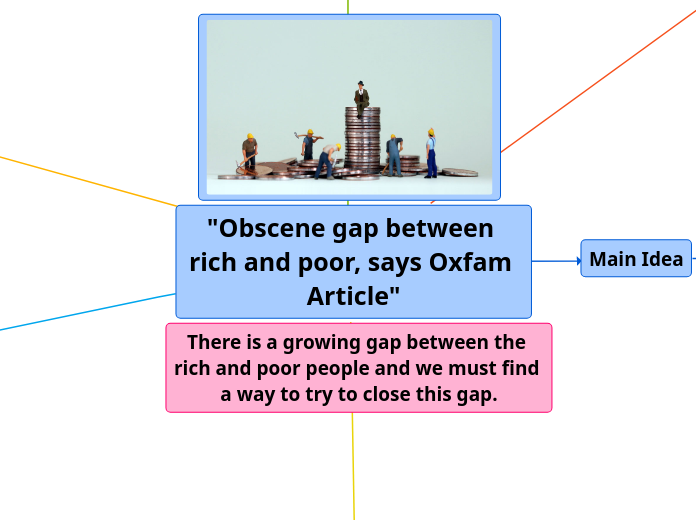"Obscene gap between rich and poor, says Oxfam Article"
Main Idea
There is a growing gap between the rich and poor people and we must find a way to try to close this gap.
"Billionaires in Canada have increased their wealth by $20 billion over the last year, says a new Oxfam report on global inequality. In the same time, the 4.5 percent of the country's wealth held by the poorest half of Canadians remained static. The report titled Public Good or Private Wealth recommends increased spending on public services and higher taxes on rich individuals and large corporations to close the gap between the world’s top money makers and the majority."

Text Structure
Problem and Solution
A text structure that presents a problem and shows the solution to the said problem immediately after presenting the problem.
First, the author presents the problem which is that there is a growing gap between the rich and the poor. Then, the author states a way to fix the problem by increasing public spending on public services and create higher taxes on rich individuals and large coorperations.
“Billionaires in Canada have increased their wealth by $20 billion over the last year, says a new Oxfam report on global inequality. In the same time, the 4.5 per cent of the country's wealth held by the poorest half of Canadians remained static. The report titled Public Good or Private Wealth recommends increased spending on public services and higher taxes on rich individuals and large corporations to close the gap between the world’s top money makers and the majority.”
The author presents the problem where people are living in extreme poverty and this extreme poverty can be passed on for generations to come. Then the author presents the solution by cracking down on the tax avoidance of large corporations and rich individuals, increase public spending on public services to create a "triple benefit" to bridge the inequality between men and woman so that more woman can join the workforce and boost their economics.
“‘(This report is) not just about making a whole lot of noise about the super rich. It’s also saying there are ways this can change,’ said Ravon. ‘We know there are very simple things that can be done to curb this trend and to make sure people that are living in extreme poverty aren’t stuck there for generations and generations.’ The report calls on governments to “crack down on tax avoidance” and ensure that the wealthy are taxed appropriately, saying that in rich countries the average top personal income tax rate fell from 62 in 1970 to 38 in 2013. Also essential to reduce inequality is increased spending on public services such as health care, education and childcare, the report says. By especially focusing on childcare, Ravon said that communities will experience the ‘triple benefit’ of bridging inequality between men and women, enabling more women to join the workforce and boost their economies.‘It really is the magic bullet,’ she said.”
Points and Proof
The wealth of billionaires rapidly increases each day, while the poorer population's wealth cannot keep up with this rapid growth, making the gap bigger.
“Worldwide, the report says billionaire wealth increased an average of $3.3 billion a day, representing a total increase of 12 per cent from 2017. In the decade since the 2008 financial crisis, the number of billionaires in the world has nearly doubled, the report also says. The data is based on the annual Forbes billionaires list There are 46 billionaires in Canada, says Forbes. The wealth held by the poorest half of the world’s population has decreased by 11 percent between June 2017 and June 2018, the report says, citing Credit Suisse’s Global Wealth Report and Global Wealth Databook.”
Many of the world’s billionaires often avoid their taxes, which helps them to increase their wealth without any barriers and also increases the gap between the rich and the poor.
“The report calls on governments to ‘crack down on tax avoidance’ and ensure that the wealthy are taxed appropriately, saying that in rich countries the average top personal income tax rate fell from 62 in 1970 to 38 in 2013.”
Persuasive Techniques
Bias
Presenting a situation with bias causes the author to only present only one side of the situation, creating a bias as not all of the information is given.
“But in Ontario, public services are increasingly jeopardized under Premier Doug Ford’s government, she said. On Jan. 17, the Progressive Conservatives eliminated free post-secondary tuition for students from low-income families under the Ontario Student Assistance Plan. In December, all current and future provincial funding for the College of Midwives of Ontario was revoked. He had already backed out on plans laid out by the previous Liberal government for universal child care and a basic universal income pilot project.”
Emotional Appeal
The author purposefully uses quotes that use emotional appeal to evoke an emotion out of the reader.
“‘We know there are very simple things that can be done to curb this trend and to make sure people that are living in extreme poverty aren’t stuck there for generations and generations.’”
Reading Strategies
Picturing/Visualizing
Picturing/Visualing helped me understand the text better by creating visual representations of different situations in the text to help me understand.
For example, when the author stated their thesis, I imagined a giant staircase with the rich at the top and the poor at the bottom and the space between them rapidly increasing.

Making Connections
Making Connections helped me understand the text better by creating connections to things I know well, which helped me understand some of the things in the article.
For example, when the author talked about the tax avoidance of rich individuals and large coorperations in order to increase their wealth with no barriers, I made a connection to the endless staircase in Super Mario 64 and how you had to keep climbing up the staircase in order to get to the top.

Text Features
Photographs
Photographs help illustrate what the article is trying to tell the reader in a visual format and also can elaborate on a few things said in the article by being used as examples.

This image helps the reader understand who the premier is and how he may be involved in the rest of the article. This image also sets thedirection of the article and where it may go.

This image gives context to the readter to who Lauren Ravon is and what she looks like.
Captions
Captions help provide context to different photographs in the article to make sure that the reader knows what the photograph is trying to convey to them.
"There is no excuse in Canada for cutting public services, as Ontario Premier Doug Ford, shown here June 29, 2018, has done, says Oxfam official Lauren Ravon. Photo by Alex Tétreault"
This caption helps give context to the image with Doug Ford in the beginning of the article and gives context to what's going on in the image.
"Lauren Ravon, Oxfam Canada's director of policy and campaigns, says that there is an 'obscene' gap between the wealthy and lower income people in Canada. She is featured here in her Ottawa office on Jan. 22, 2019. Photo by Caroline Leal, courtesy of Oxfam"
This caption gives context of who's in the image and how she's involved in the article.

Italics
Italics help us differentiate what’s important and not important. Italics can also be used to tell the reader what’s the name of a different piece of media the article is referring to.
"Forbes billionaires list"
In this situation, Italics is used to refer to a piece of media the article is reffering to, which is a Forbes, a business-based website.
"Global Wealth Report and Global Wealth Databook"
In this situation, Italics are used to differentiate what is important and refer to a piece of media. This report is used throughout the entire article to help make points for the author to support their thesis.

There is a growing gap between the rich and poor people and we must find a way to try to close this gap.






